CHWD Demonstration Garden
CHWD has developed a demonstration garden to help our customers make water-efficient plant choices. Our garden is composed of six planter boxes with different landscape themes; from Low Water California Native Plants to Moderate Water Edibles. The aerial garden photo below can be used as an educational tool to help you choose water-efficient plants for your yard and garden.
When you’re done exploring the various plants, add your favorites to a plant shopping list by clicking the “Create Your Own Custom Plant List” button below!
Interactive Plant Map
Click on a plant to learn more about it.

Leafy Reed Grass / Calamagrostis Foliosa
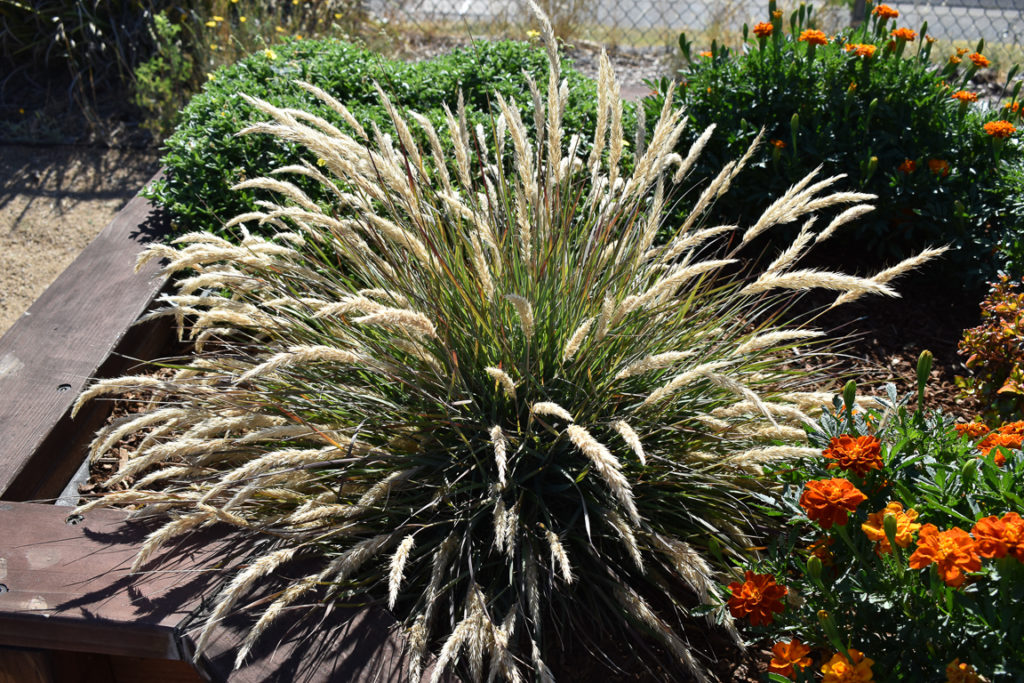
The Leafy Reed Grass is native to California and is naturally found on rocky slopes. This grass creates an aesthetic fountain shape with its tips being weighed down by seed heads and can be used as a low-maintenance complement to a garden. A mature plant will grow to around 2 feet in height and width, producing blue-green leaves composed of purplish streaks. Although no maintenance is required, one could cut back growth in early March to prepare for spring.
| Categories | Plant Information |
|---|---|
| Plant Type | Perennial Grass |
| Common Name | Leafy Reed Grass |
| Botanical Name | Calamagrostis Foliosa |
| Water Needs | Low |
| Light Requirement | Partial to Full Sun |
| Flower Color | Brown Flower Spikes |
| Bloom Period | Spring to Early Winter |
Shasta Daisy / Leucanthemum x superbum
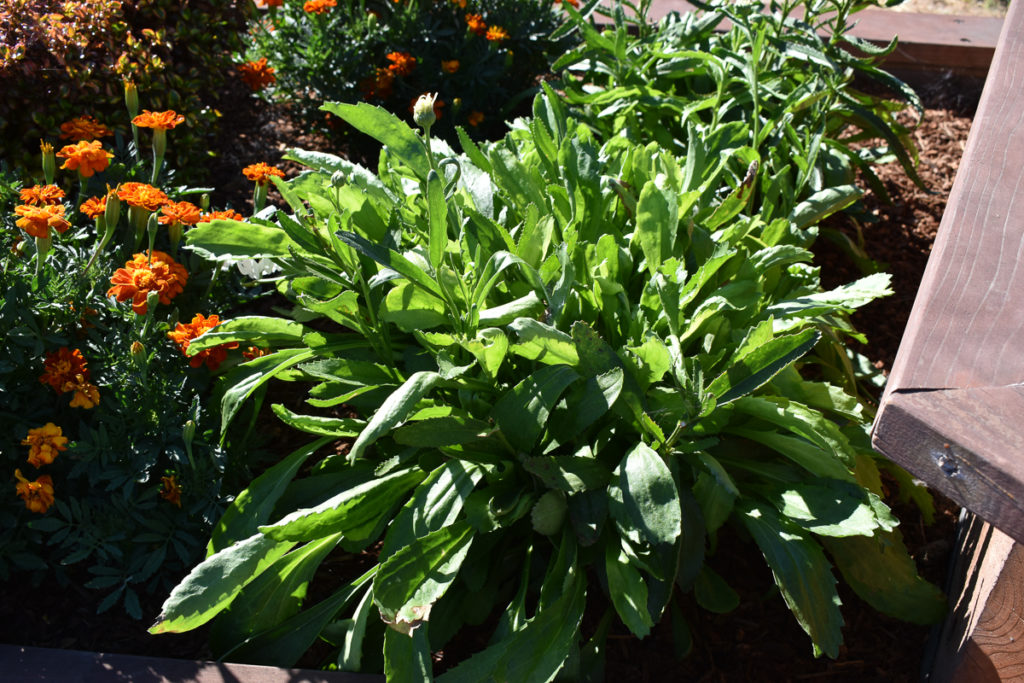
Despite its name, the Shasta Daisy, named after the snowy Shasta Mountains, is not native to California but is a hybrid of two other daisies. The Shasta Daisy grows quite well in the region, requiring little water and direct sunlight, and flourishes during our hot summers. It can grow from a range of 6 inches to 3 feet and acts as a pollinator for bees, butterflies, and birds.
| Category | Plant Information |
|---|---|
| Plant Type | Flowering Perennials |
| Common Name | Shasta Daisy |
| Botanical Name | Leucanthemum x superbum |
| Water Needs | Low |
| Light Requirement | Full Sun |
| Flower Color | White |
| Bloom Period | Spring to Fall |
Marigolds / Tagetes
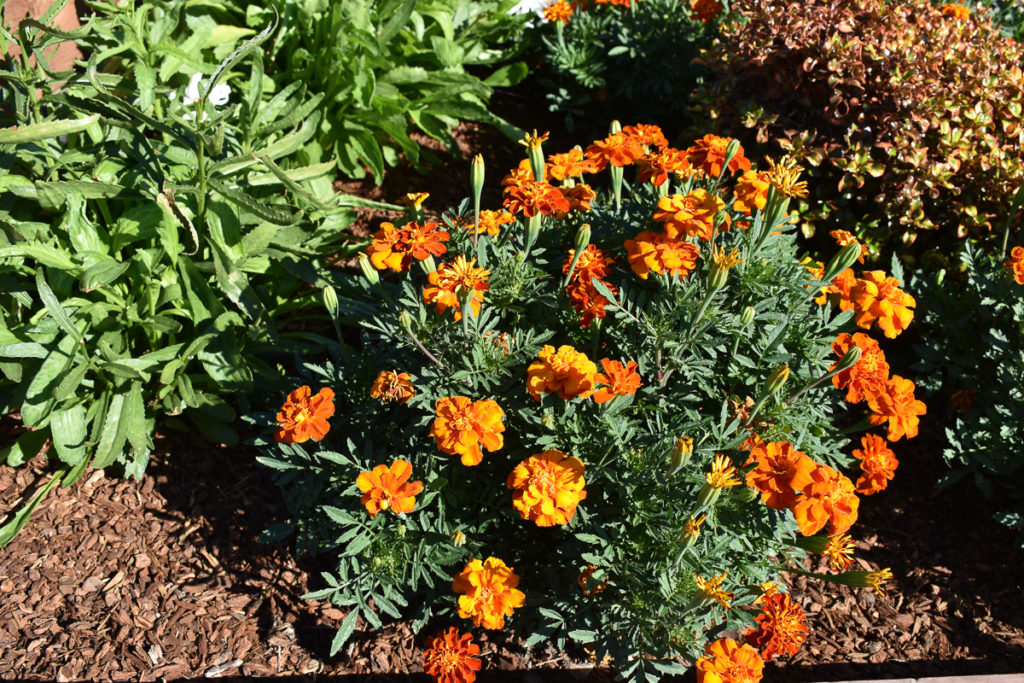
Originally native to Mexico, Marigolds are annuals planted in our Moderate Water, Colorful Flowers & Foliage box. Aside from being drought tolerant, they also attract a number of beneficial insects while repelling other harmful insects such as cabbage worms and hornworms. Because of their insect repelling qualities, they are commonly planted near tomatoes, bush beans, squash, cucumber, and eggplants. In the best conditions, Marigolds grow fast and produce many flowers throughout the summer season. To encourage this growth, deadheading and pruning are required.
| Category | Plant Information |
|---|---|
| Plant Type | Flowering Annual |
| Common Name | Marigold |
| Botanical Name | Tagetes |
| Water Needs | Moderate |
| Light Requirement | Full Sun |
| Flower Color | Yellow/Orange/Red |
| Bloom Period | Early Summer through Late Fall |
Tequila Sunrise Mirror Plant / Coprosma Repens
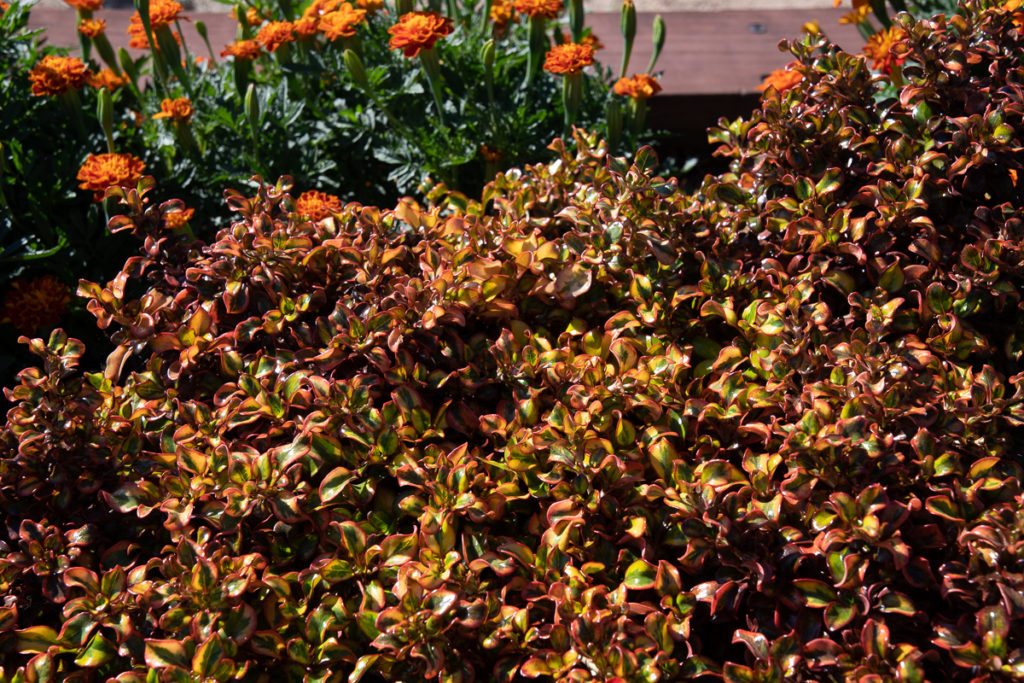
Tequila Sunrise Mirror Plant is a low-maintenance bush or shrub that has shiny leaves with red, orange, green, and yellow colors. The bush can grow to about 5 feet high and is often used in mass plantings, acting as a hedge or accent. Tequila Sunrise can be pruned at any time of year and is easily shaped.
| Category | Plant Information |
|---|---|
| Plant Type | Bush |
| Common Name | Tequila Sunrise Mirror Plant |
| Botanical Name | Coprosma Repens |
| Water Needs | Moderate |
| Light Requirement | Full Sun |
| Flower Color | None |
| Bloom Period | None |
Garden Nugget Rock Rose / Helianthemum X Nummularium
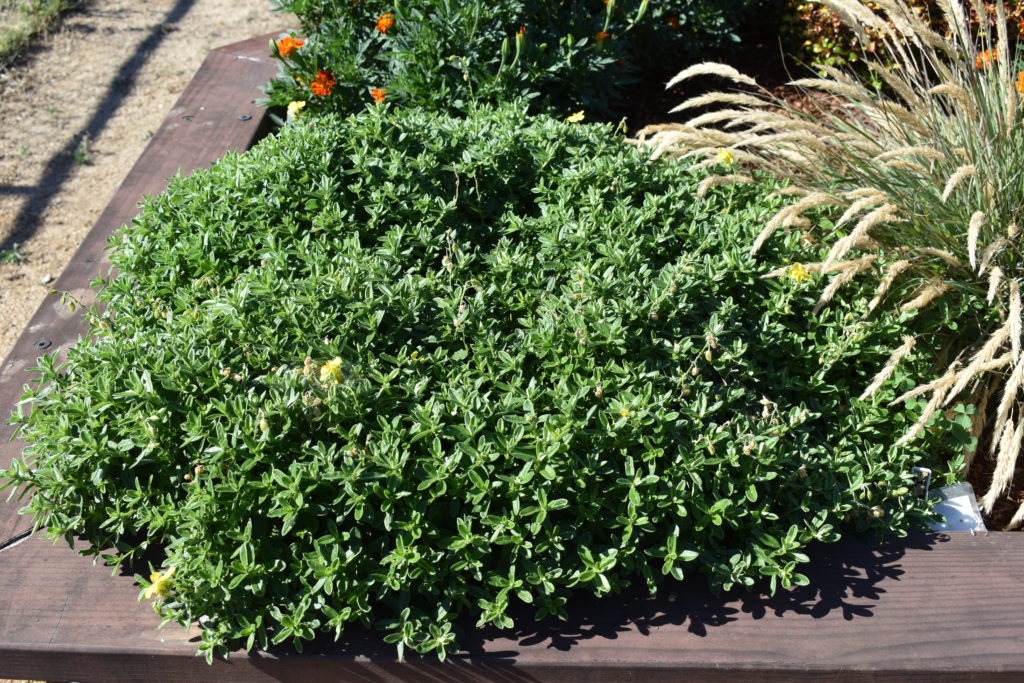
The Garden Nugget Rock Rose is drought-tolerant and grows best in alkaline, rocky, or sandy soil. Commonly used as a ground cover, this perennial will spread to around 24 to 36 inches and only grows to around a foot in height. Little maintenance is required of the Rock Rose, other than shearing back growth in mid to late spring.
| Categories | Plant Information |
|---|---|
| Plant Type | Herbaceous Perennial |
| Common Name | Garden Nugget Rock Rose |
| Botanical Name | Helianthemum X Nummularium |
| Water Needs | Low |
| Light Requirement | Full Sun |
| Flower Color | Pink or Yellow |
| Bloom Period | Summer |
Wayne Roderick Daisy / Erigeron Glaucus
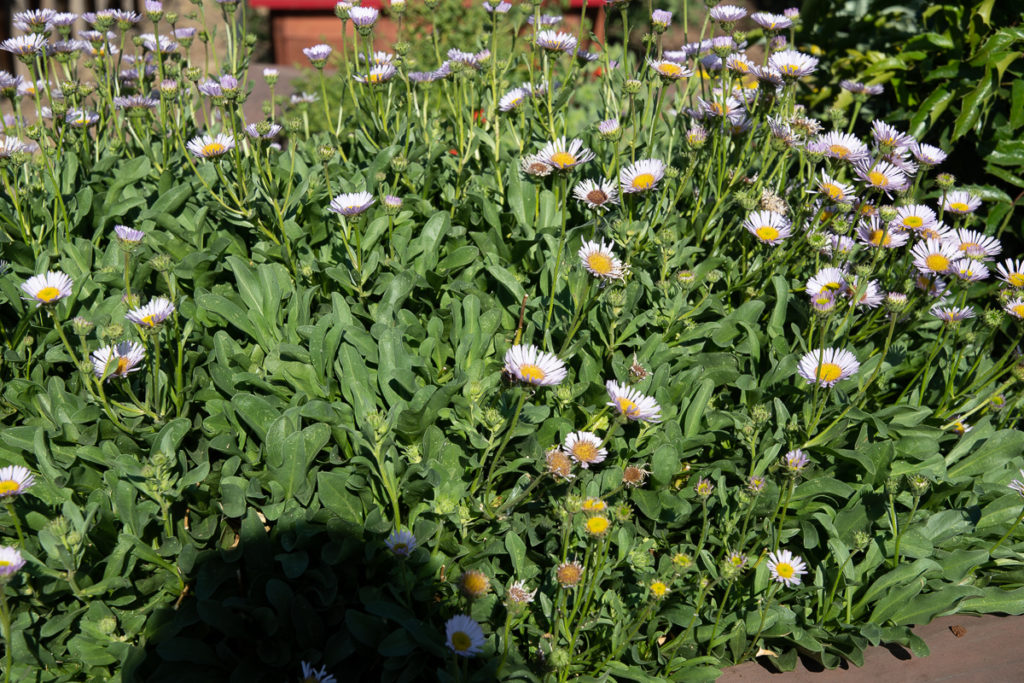
Our Wayne Roderick Daisy lives in the California Native Plot. Commonly found by the coast, Roderick Daisies are a hardy perennial that can thrive in various soil conditions and are excellent at attracting native bees and butterflies. The Roderick Daisy is deer resistant, drought-tolerant, and comfortable in windy climates. Altogether, the Wayne Roderick Daisy is a great choice for a garden where you will enjoy beautiful flowers spring through the end of summer.
| Category | Plant Information |
|---|---|
| Plant Type | Native Flowering Perennial |
| Common Name | Wayne Roderick Daisy |
| Botanical Name | Erigeron Glaucus |
| Water Needs | Low |
| Light Requirement | Full Sun |
| Flower Color | Purple/Blue |
| Bloom Period | Spring through Summer |
California White Sage / Salvia Apiana
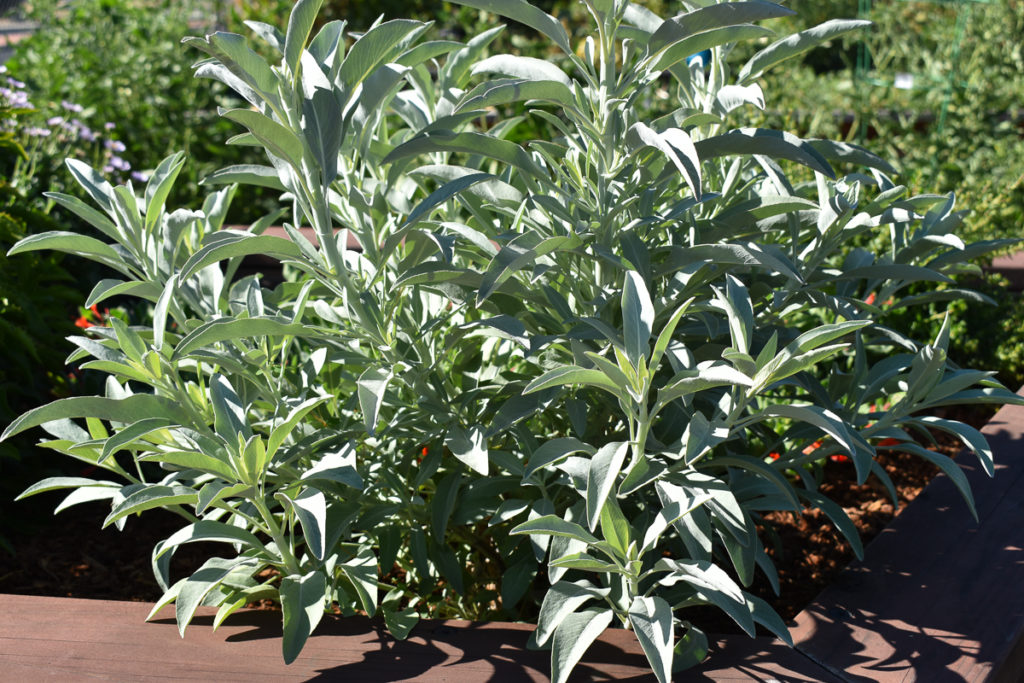
Native to southwestern California, this shrub has silvery-white leaves and a strong, soothing fragrance. The Southern California region it comes from is distinct, as it’s the only area in the world to naturally produce White Sage. The shrub tends to grow very slow but can reach a height of around 5 feet and a width of 8 feet, but annual pruning in early to mid-fall will help keep the Sage at your desired size. Lastly, White Sage is a pollinator producing small clusters of white flowers that attract bees, butterflies, moths, and birds.
| Category | Plant Information |
|---|---|
| Plant Type | Native Perennial Shrub |
| Common Name | California White Sage |
| Botanical Name | Salvia Apiana |
| Water Needs | Very Low |
| Light Requirement | Full Sun |
| Flower Color | White |
| Bloom Period | Winter through Summer |
California Fuchsia “Everett’s Choice” / Epilobium or Zauschneria Californica
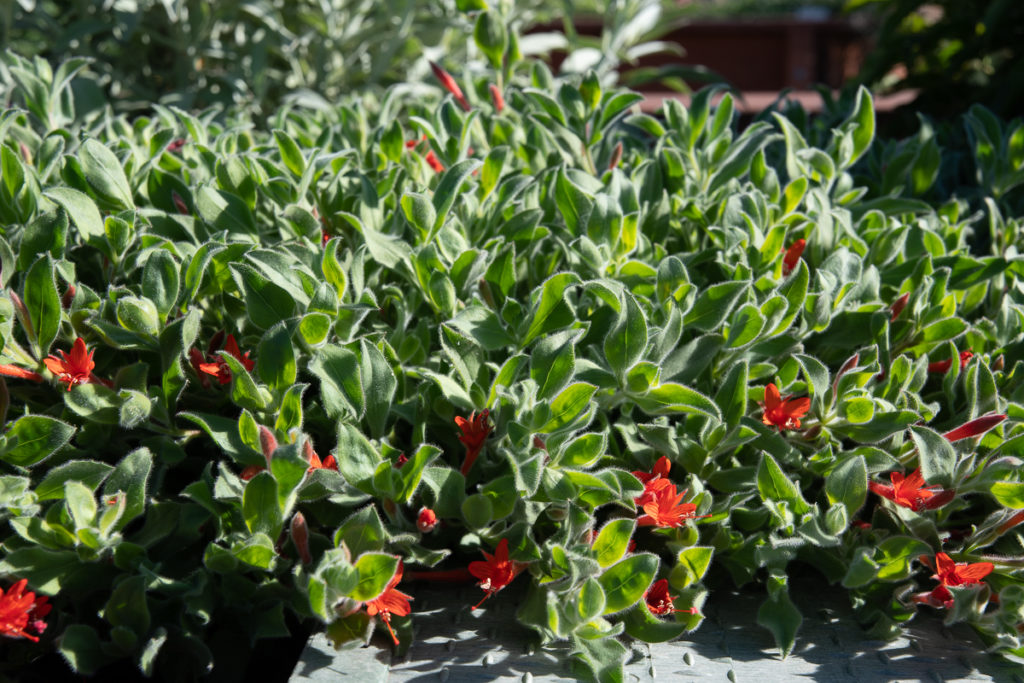
The California Fuchsia, (the “Everett’s Choice” variety) is native to the foothills of California and is a low-growing bush with vibrant scarlet red flowers. It has a long bloom period starting in the early summer and extending through fall. The scarlet, cone-like flowers “Everett’s Choice” produces are a hummingbird favorite and attract many other pollinators. The plant commonly grows to about a foot in height but likes to spread to around 2 to 3 feet wide. A light pruning in late fall helps revive the plant for the next season.
| Category | Plant Information |
|---|---|
| Plant Type | Flowering Perennial Bush |
| Common Name | California Fuchsia |
| Botanical Name | Epilobium or Zauschneria Californica |
| Water Needs | Low |
| Light Requirement | Full Sun |
| Flower Color | Red |
| Bloom Period | Summer through Fall |
Compact Oregon Grape / Mahonia Aquifolium
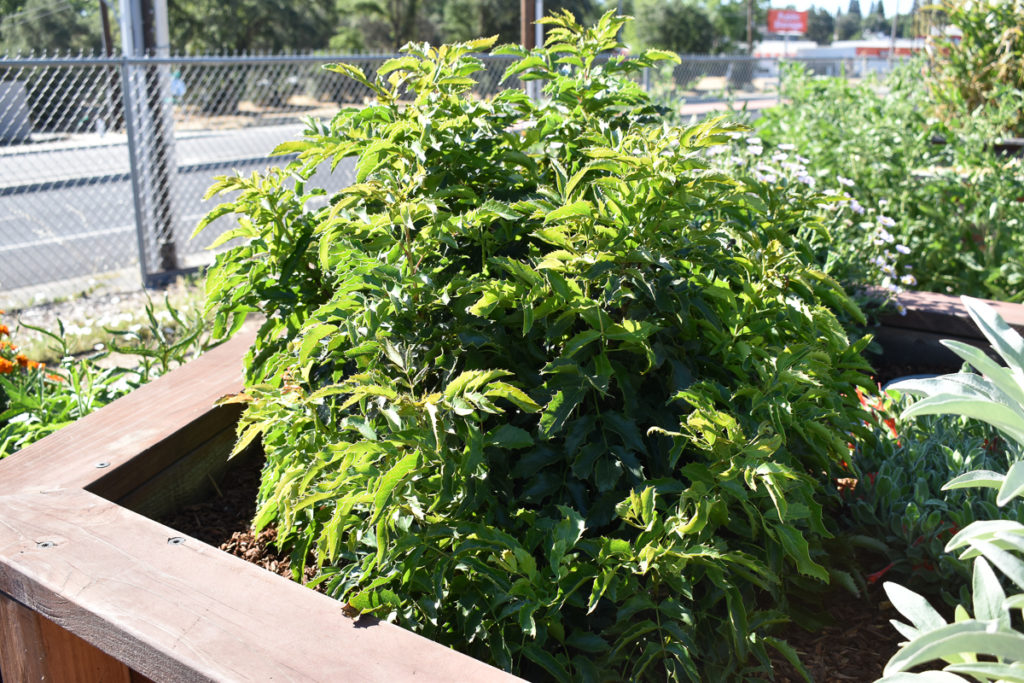
The Compact Oregon Grape grows best in moist and well-drained acidic soils. This evergreen shrub can spread its spikey leaves to grow to about 3 feet tall and 5 feet wide. Being native to California the Compact Oregon Grape requires little maintenance but rewards your garden with showy yellow flowers in the spring.
| Category | Plant Information |
|---|---|
| Plant Type | Native Perennial Bush |
| Common Name | Compact Oregon Grape |
| Botanical Name | Mahonia Aquifolium |
| Water Needs | Low to Moderate |
| Light Requirement | Full Sun or Partial Shade |
| Flower Color | Yellow |
| Bloom Period | Spring |
Twin Peaks Coyote Brush / Baccharis Pilularis

This native perennial shrub serves as an excellent ground cover and requires little water once established. Interestingly, in the summer it prefers water only once a month. The cream-colored flowers produced act as a great attractor for bees and other pollinators.
| Category | Plant Information |
|---|---|
| Plant Type | Native Perennial Shrub |
| Common Name | Twin Peaks Coyote Brush |
| Botanical Name | Baccharis Pilularis |
| Water Needs | Low |
| Light Requirement | Full Sun |
| Flower Color | Cream |
| Bloom Period | Summer to Winter |
Yellow Yarrow / Eriophyllum Confertiflorum

Golden or Yellow Yarrow is a part of the daisy family and is commonly a perennial, but can be found as an annual in certain climates. Native to California, Yellow Yarrow can grow from the Sierra Nevada foothills to the Coastline. Yellow Yarrow is often used for xeriscaping requiring little water, and excessive watering can actually cause the plant to struggle and fall over. The flowers form on each stem in bright yellow clusters and are most happy in full sun.
| Category | Plant Information |
|---|---|
| Plant Type | Native Flowering Perennial |
| Common Name | Yellow Yarrow |
| Botanical Name | Eriophyllum Confertiflorum |
| Water Needs | Low |
| Light Requirement | Full Sun |
| Flower Color | Yellow |
| Bloom Period | Winter, Spring, Summer |
Little Miss Sunshine Cistus / Cistus Corbariensis
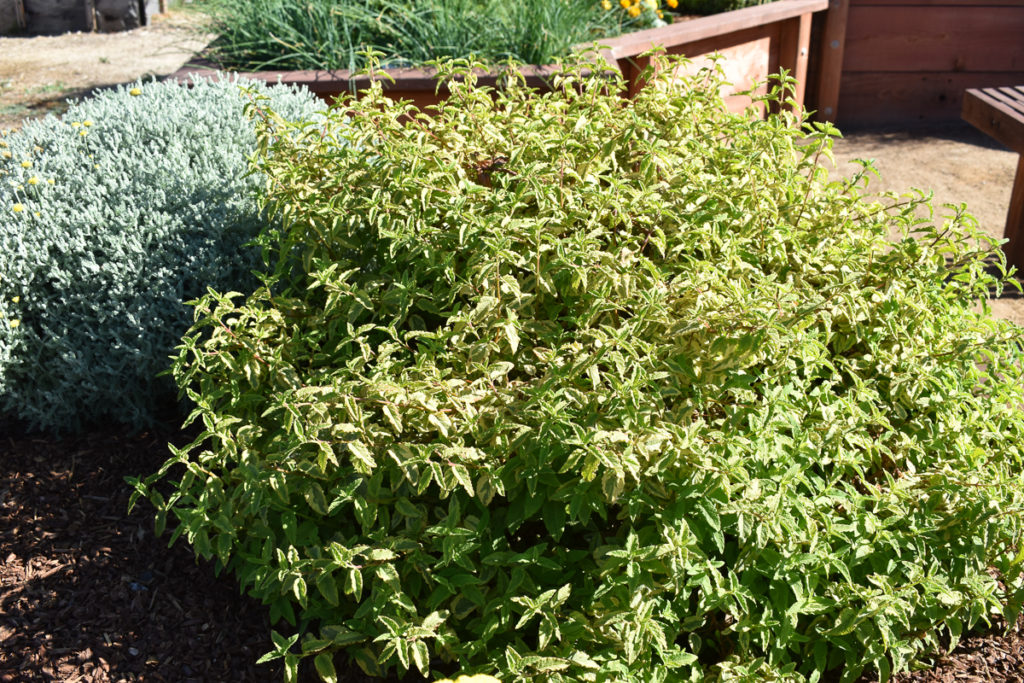
The Little Miss Sunshine Cistus is a hardy perennial that can survive the worst of conditions: poor soil, drought, wind, and saline waters. Little Miss Sunshine needs little maintenance with no pruning required as it stays compact, around 1 to 2 feet tall and 1 to 1.5 feet wide. Along with the other listed positives, Cistus also produces beautiful white flowers in the spring.
| Category | Plant Information |
|---|---|
| Plant Type | Flowering Perennial Shrub |
| Common Name | Little Miss Sunshine Cistus |
| Botanical Name | Cistus Corbariensis |
| Water Needs | Low |
| Light Requirement | Full Sun |
| Flower Color | White |
| Bloom Period | Spring |
Lavender Cotton / Santolina Chamaecyparissus
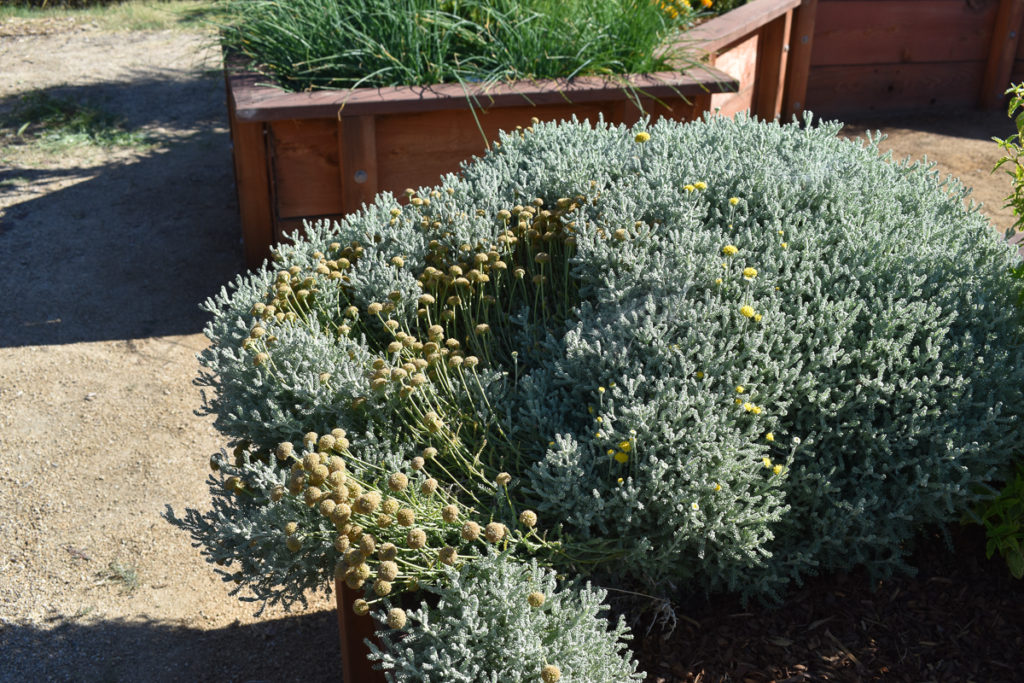
Lavender Cotton is a fragrant evergreen shrub that produces bright yellow round flowers in the spring and summer. It is hardy in a variety of conditions and will reach a size of around 2 feet in height and 3 feet in width. Lavender Cotton is commonly used as an attractive groundcover on borders or on the edges of walking paths which can also help deter deer, rabbits, and other menaces from one’s garden. Lastly, its fragrant aroma and round flowers attract pollinators such as bees and butterflies.
| Category | Plant Information |
|---|---|
| Plant Type | Flowering Perennial Shrub |
| Common Name | Lavender Cotton |
| Botanical Name | Santolina Chamaecyparissus |
| Water Needs | Low |
| Light Requirement | Full Sun |
| Flower Color | Yellow |
| Bloom Period | Summer |
Lemon Thyme / Thymus x Citriodorus
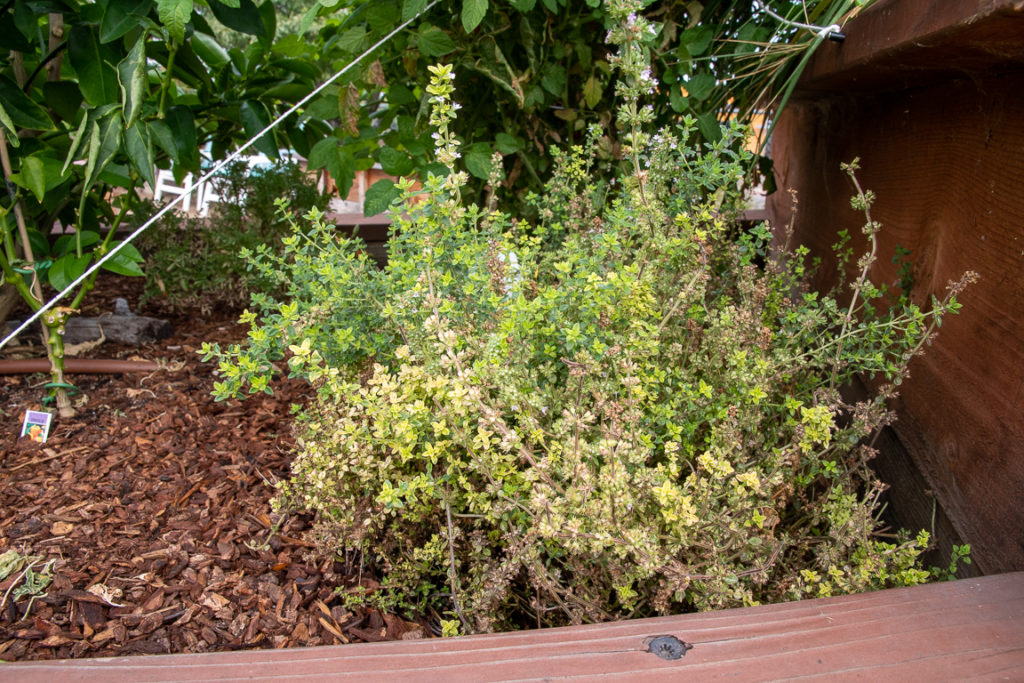
Lemon Thyme is a popular herb that is planted both for its culinary uses and its aesthetic qualities. Growing low and wide, the herb can be used as a groundcover or a garden border. Needing little water and being able to survive with variable sun makes this plant an easy keeper.
| Category | Plant Information |
|---|---|
| Plant Type | Perennial Edible Herb |
| Common Name | Lemon Thyme |
| Botanical Name | Thymus x Citriodoru |
| Water Needs | Low |
| Light Requirement | Full Sun to Partial Shade |
| Flower Color | Light Purple |
| Bloom Period | Early Summer |
Chef’s Choice Rosemary / Rosmarinus Officinalis
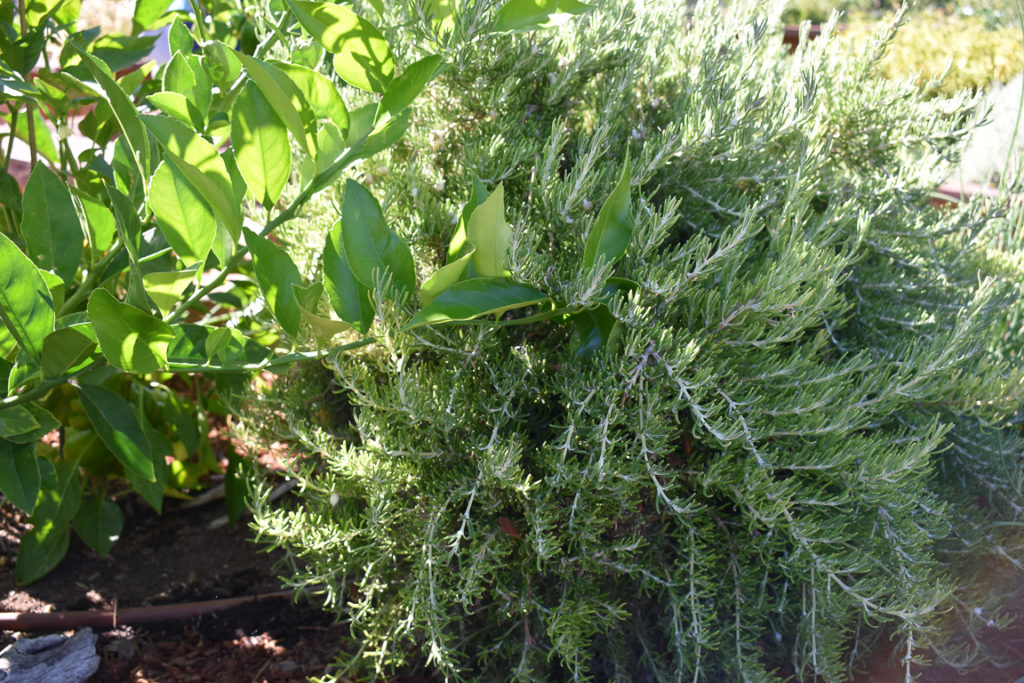
Chef’s Choice Rosemary is an edible herb that is known for having a higher oil content and a spicier flavor than typical varieties of Rosemary. Once established, Chef’s Choice needs little water and grows best in permeable, well-drained soils. Chef’s Choice Rosemary is an evergreen, requires full sun, and in the best conditions can grow up to 2 feet tall and wide. Its strong aromatic smell attracts many pollinators such as bees, butterflies, and birds. Also, these pollinators can enjoy the violet blue flowers produced by the Rosemary in spring.
| Category | Plant Information |
|---|---|
| Plant Type | Perennial Edible Herb |
| Common Name | Chef’s Choice Rosemary |
| Botanical Name | Rosmarinus Officinalis |
| Water Needs | Low |
| Light Requirement | Full Sun |
| Flower Color | Purple |
| Bloom Period | Spring |
Meyer Lemon Tree / Citrus x Meyeri
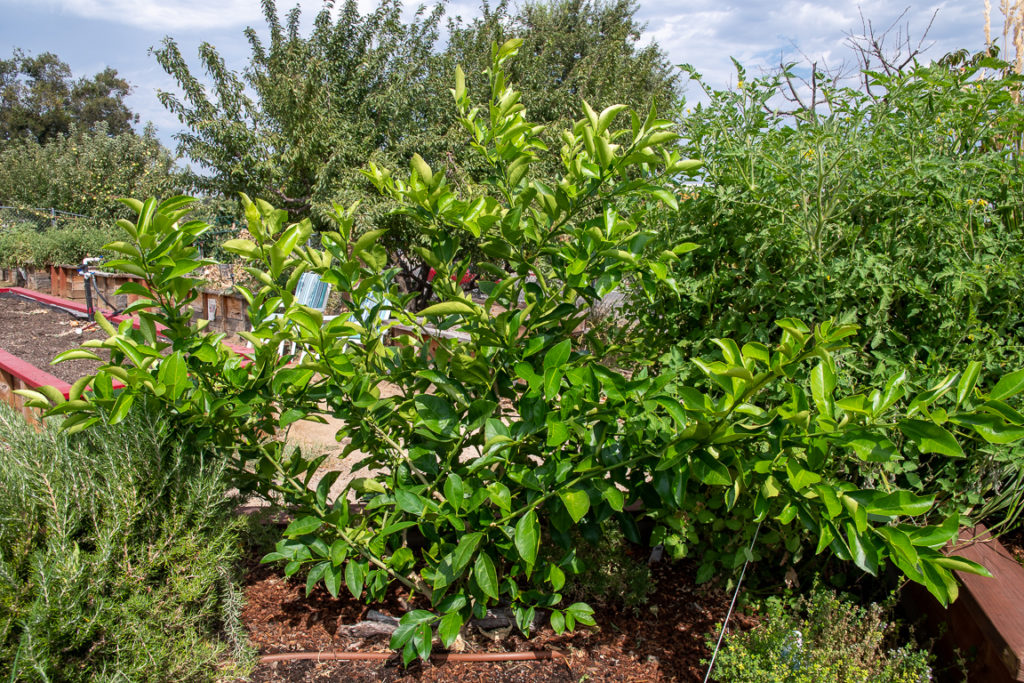
Meyer Lemons are a cross between lemons and mandarin oranges. This cross produces a thin-skinned fruit that is much sweeter than a regular lemon. The standard dwarf tree grows to about 6 feet tall and will spread its leaves to about 4 feet in diameter. The Meyer Lemon grows best in soils that are moist but can drain well, and it prefers full to partial shade. After around two years of growth, the tree should produce its first fruit and have its heaviest harvests in the winters.
| Category | Plant Information |
|---|---|
| Plant Type | Fruit Tree |
| Common Name | Meyer Lemon |
| Botanical Name | Citrus x Meyeri |
| Water Needs | Low |
| Light Requirement | Full Sun to Partial Shade |
| Flower Color | White |
| Bloom Period | Spring |
Pepper “Green Bell” / Capsicum annuum

Bell peppers can be very temperamental but act as a worthy challenge for any gardener testing their skills. They thrive in the warmth of summer producing small white flowers which will in time turn into their fruits and can grow to a little over 2 feet tall. A full crop can weigh heavy on the plant; therefore, Bell Peppers need to be staked early to prevent damage. Bell Peppers need a regular watering schedule and attentive care to produce a great crop.
| Category | Plant Information |
|---|---|
| Plant Type | Annual Edible Fruit |
| Common Name | Bell Pepper |
| Botanical Name | Capsicum annuum |
| Water Needs | Low to Moderate |
| Light Requirement | Full Sun |
| Flower Color | White |
| Bloom Period | Summer |
Chives / Allium schoenoprasum
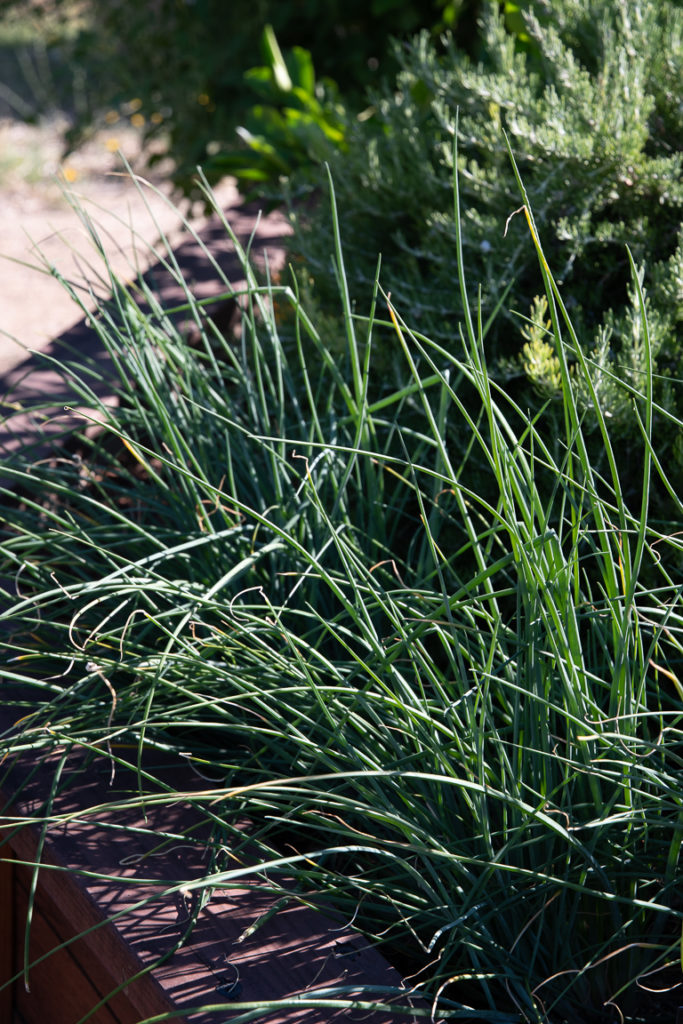
Chives are evergreen perennials in the onion family. Comfortable in both hot summer days and cool winter frosts, chives will grow fast and spread rapidly if not managed. Also used as a companion plant, chives can help deter pests from other crops, such as carrots, lettuce, and tomatoes. Chives produce a purple flower which, if not pruned early, will spread seeds and possibly result in unwanted growth.
| Category | Plant Information |
|---|---|
| Plant Type | Edible Herb |
| Common Name | Chives |
| Botanical Name | Allium schoenoprasum |
| Water Needs | Moderate |
| Light Requirement | Full Sun |
| Flower Color | Purple |
| Bloom Period | Mid Spring to Early Summer |
Tomato ‘Red Cherry’ / Solanum lycopersicum

Red Cherry Tomatoes enjoy full sun and warm seasons. Growing rapidly, this vine needs to be staked and pruned if you would like to keep it away from your other plants. Tomatoes can be drought tolerant but they need to be trained to require less water and in turn, the plant will produce richer fruits. This happens for two reasons, first less water forces the plant to focus less on leaf growth and concentrate more on fruit production. Second, it encourages the roots to grow deeper in search of moisture, in doing so accessing more nutrients that produce a stronger flavor.
| Category | Plant Information |
|---|---|
| Plant Type | Fruit Vine |
| Common Name | Tomato ‘Red Cherry’ |
| Botanical Name | Solanum lycopersicum |
| Water Needs | Moderate |
| Light Requirement | Full Sun |
| Flower Color | Yellow |
| Bloom Period | Summer |
Karl Forester Feather Reed Grass / Calamagrostis x Acutiflora

Karl Forester Feather Reed Grass is a cool season grass that typically has the most growth in the spring before the hot summer temperatures. In the spring, Karl Forester Grass produces feathery plumes with light bronze colors that last for most of the year. The Grass is commonly used as a dramatic accent in gardens, and it can grow to about 5 feet tall with a spread of around 3 feet. Karl Forester is easy to grow and requires little maintenance other than cutting back growth once per year in the winter or early spring.
| Category | Plant Information |
|---|---|
| Plant Type | Grass |
| Common Name | Feather Reed Grass |
| Botanical Name | Calamagrostis Foliosa |
| Water Needs | Moderate |
| Light Requirement | Full Sun |
| Flower Color | Red |
| Bloom Period | Late Spring through Fall |
Heavenly Bamboo “Firepower”/ Nandina Domestica

Heavenly Bamboo “Firepower” is an aesthetically pleasing bush with unique red, yellow, and orange coloring. Commonly used as a border, this bush provides accent colors with little pruning and maintenance. During the fall and winter seasons, the red coloring will intensify matching the typical seasonal fall colors. Heavenly Bamboo requires low water once established and is most happy in full sun.
| Category | Plant Information |
|---|---|
| Plant Type | Bush or Shrub |
| Common Name | Heavenly Bamboo Firepower |
| Botanical Name | Nandina Domestica |
| Water Needs | Low to Moderate |
| Light Requirement | Full Sun |
| Flower Color | White |
| Bloom Period | Spring or Summer |
White and Pink Myoporum / Myoporum Parvifolium
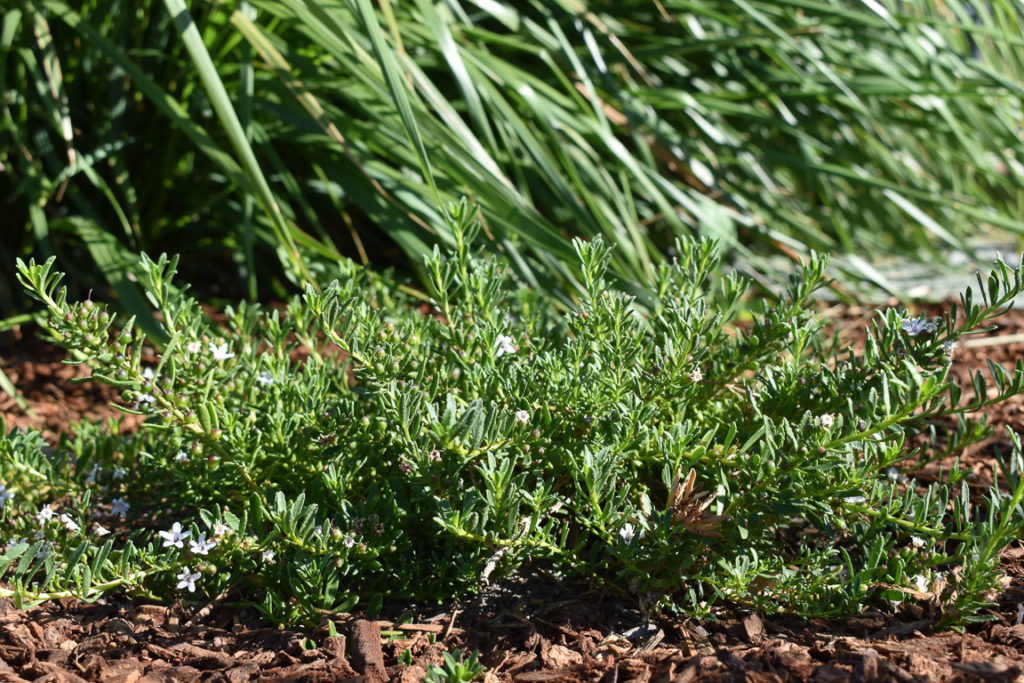
Commonly used as a ground cover, this evergreen flowering perennial shrub grows to about 4 inches in height and can spread to 5 to 10 feet in diameter. Myoporum is easily maintained and can grow in a variety of conditions from full sun to full shade. Myoporum is also drought tolerant requiring little water and produces small pink or white flowers depending on the variety.
| Category | Plant Information |
|---|---|
| Plant Type | Perennial Shrub |
| Common Name | White and Pink Myoporum |
| Botanical Name | Nandina Domestica |
| Water Needs | Low to Moderate |
| Light Requirement | Full Sun |
| Flower Color | White |
| Bloom Period | Spring or Summer |
African Daisy / Osteospermum pps.

The African Daisy is a low-water perennial that looks like a classic daisy but produces a much more vibrant and colorful flower. Altogether the African Daisy requires less than 1 inch of water per week. In times of intense heat, the plant’s growth rate will slow and become dormant if conditions are severe. Growing to about 3 feet in height and 1 foot tall, these perennials are a nice choice for flower beds or to be potted around the yard. Little maintenance is required by the African Daisy although deadheading and occasional pruning will encourage new growth.
| Category | Plant Information |
|---|---|
| Plant Type | Flowering Annuals and Perennial |
| Common Name | African Daisy |
| Botanical Name | Osteospermum |
| Water Needs | Low |
| Light Requirement | Full Sun |
| Flower Color | Pink, Yellow, White, Orange, Red, Purple |
| Bloom Period | Late Spring, Early Summer |
Coneflower / Echinacea Hybrid
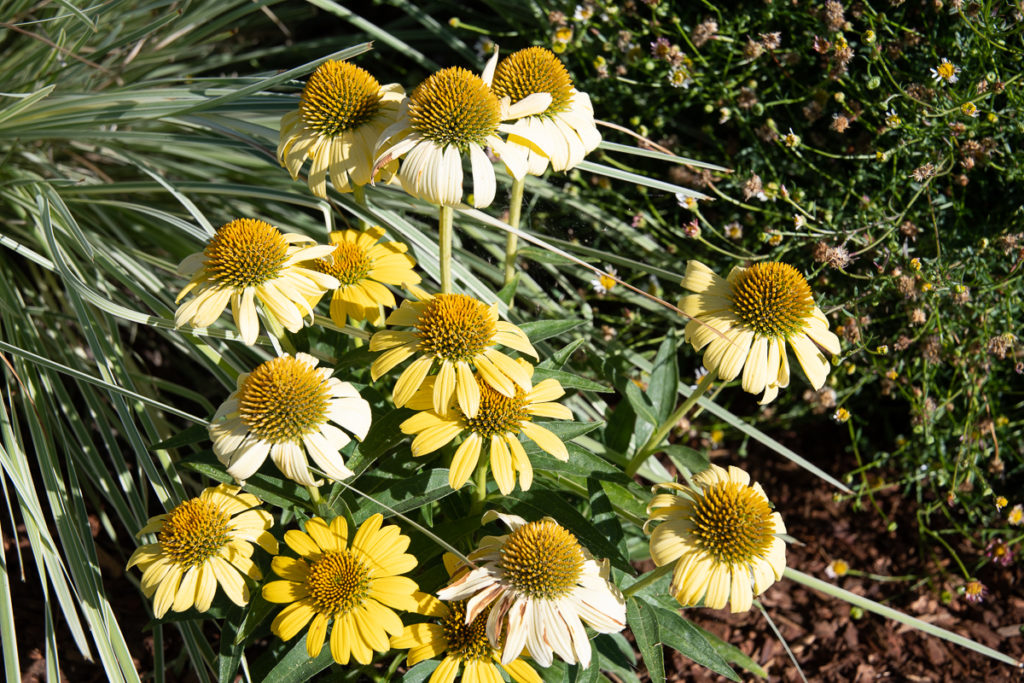
The Coneflower’s botanical name takes inspiration from the hedgehog, which in Latin is “echinus.” This name refers to the prickly cone center of the flower which protrudes out from the petals, attracting bees, butterflies, songbirds, and goldfinches. Once established, the Coneflower grows fast, reaching a height between 2 to 4 feet. The Echinacea does require pruning, continuous deadheading throughout its bloom period, and cutting it down to ground level over winter. Lastly, the water requirements of the Coneflower can range from low to moderate with about an inch of water weekly.
| Category | Plant Information |
|---|---|
| Plant Type | Flowering Perennial |
| Common Name | Coneflower |
| Botanical Name | Echinacea |
| Water Needs | Low to Moderate |
| Light Requirement | Full Sun to Partial Shade |
| Flower Color | Purple, Pink, Red, Orange, White, Yellow, Green |
| Bloom Period | Early Summer to Early Fall |
Santa Barbara Daisy / Erigeron Karvinskianus

The Santa Barbara Daisy is a short, fast-growing, and heavy flowering perennial that is commonly used as a groundcover or in a pot. Also known as Fleabane, this plant is commonly thought of as a weed in many parts of the world due to its hardiness and ability to spread if unkept. Santa Barbara Daisy’s numerous flowers attract bees, wasps, butterflies, and other beneficial insects. For maintenance, cut back in early fall to ensure it does not spread wild.
| Category | Plant Information |
|---|---|
| Plant Type | Flowering Perennial |
| Common Name | Santa Barbara Daisy or Latin American Fleabane |
| Botanical Name | Erigeron Karvinskianus |
| Water Needs | Low |
| Light Requirement | Full Sun |
| Flower Color | White and Pink |
| Bloom Period | Early Spring to Fall |
Platinum Beauty Lomandra / Lomandra Longifolia
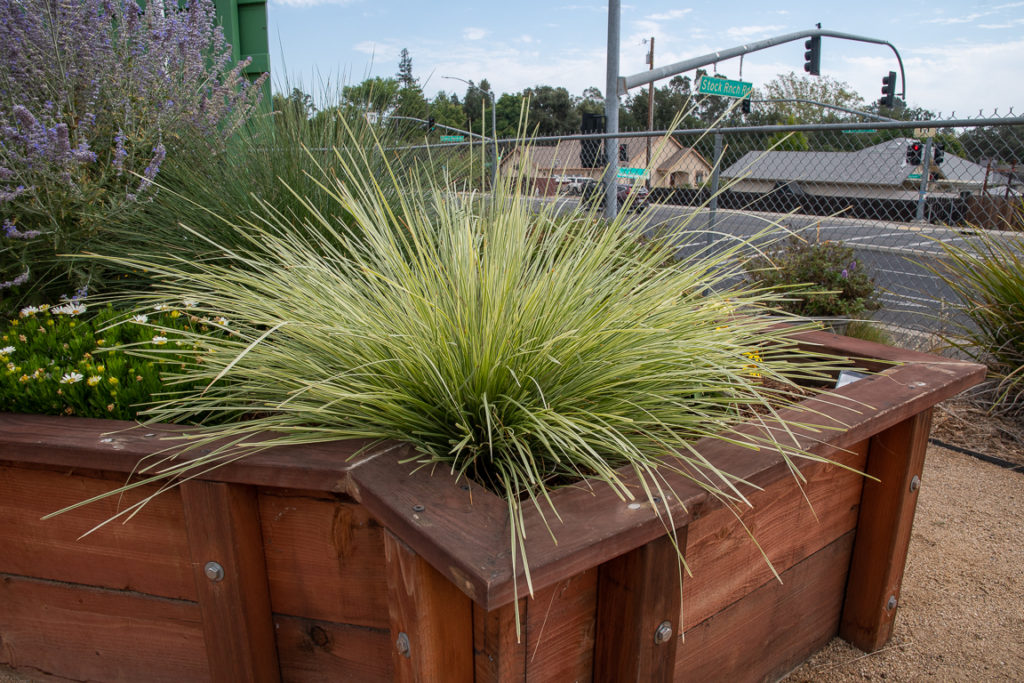
Platinum Beauty Lomandra is an evergreen perennial grass that has green and white blades serving as a constant complementing piece in the garden. Lomandra is an easy keeper with low water requirements and no required maintenance, and it thrives in tough, hard-to-manage soils. With a relatively slow growth rate, it will reach a full size of around 3 feet in height and width. This perennial serves as a staple in any drought-tolerant garden.
| Category | Plant Information |
|---|---|
| Plant Type | Evergreen Perennial Grass |
| Common Name | Platinum Beauty Lomandra |
| Botanical Name | Lomandra Longifolia |
| Water Needs | Low |
| Light Requirement | Full to Partial Shade |
| Flower Color | None |
| Bloom Period | None |
Blue Spires Russian Sage / Perovskia Atriplicifolia Blue Spires

Preferring dry conditions with well-drained soils, Blue Spires Russian Sage is a beautiful addition to drought-tolerant landscaping. With long spires that grow in early spring and develop into light purple flowers in mid-summer, this perennial acts as a vibrant pop of color until the end of autumn. Requiring full sun and a large space, Blue Spires Russian Sage likes to spread itself to about 4 feet in height and width. Russian Sage is a very effective pollinator attracting bees and many other beneficial insects. For maintenance, be prepared to cut back in early spring, dig up suckers throughout the spring and summer, and clean flower petals that fall throughout its bloom.
| Category | Plant Information |
|---|---|
| Plant Type | Flowering Perennial |
| Common Name | Lacy Blue Russian Sage |
| Botanical Name | Perovskia Atriplicifolia |
| Water Needs | Low |
| Light Requirement | Full Sun |
| Flower Color | Purple |
| Bloom Period | Mid-Summer to Fall |
Regal Mist Pink Muhly Grass / Muhlenbergia Capillaris

Regal Mist Pink Muhly Grass is a clumping ornamental grass that produces delightful light pink flowers in the fall. Muhly Grass will grow to about 3 feet tall with its fall flowering coming from shoots that extend an extra 1 to 2 feet. A very easy plant to grow, Regal Mist Pink Muhly Grass can adapt to most soil types and can live in both full sun and partial shade. In late winter, it is best practice to cut back Muhly Grass almost to the ground so it can reinvigorate itself for the upcoming season of growth.
| Category | Plant Information |
|---|---|
| Plant Type | Grass |
| Common Name | Regal Mist Pink Muhly Grass |
| Botanical Name | Muhlenbergia Capillaris |
| Water Needs | Low to Moderate |
| Light Requirement | Full or Partial Sun |
| Flower Color | Pink |
| Bloom Period | Late Summer to Fall |
Community Garden Corps
CHWD has acquired plots at the Sylvan Ranch Community Garden to showcase water-efficient garden practices. We are looking for volunteers to help us maintain these plots. If you are interested, please sign up for more information below:

